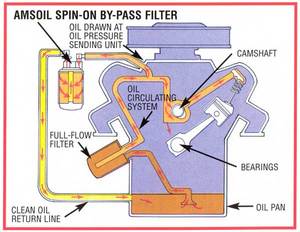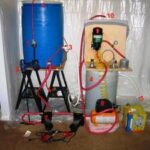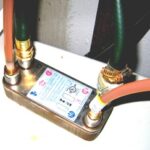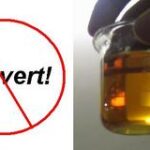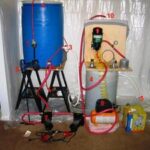CLASS NAME: BY-PASS OIL FILTER 101
Today’s lesson objectives, boys and girls:
– You will learn about inexpensive and readily available technology that pretty much kills engine wear that occurs while running your engine.
– As an added benefit, this same technology pretty much offers the physical equivalent of an oil change for every 10 minutes you operate your car!
– You will learn how by-pass oil filtration works, and I’ll give you a hint on where you can get it.
Interested? Read on!
(For other articles on cars and other cool stuff – like biodiesel – go here.
MY FRIEND’S STORY
In our disposable society we unfortunately treat our cars as one of those throw-away items. As we approach 100,000 miles with our cars, many of us get that funny feeling – that “I-need-a-new-car” feeling. Seems like we have been conditioned to think that a car becomes useless or unreliable when it hits the “Big 100”. Case in point…
A friend just came up to me, all smiles, and showed me her new car. She proudly stated, “I really loved my old car. I especially loved the fact that it was all paid off. But I was afraid how long the engine would last as it got older. I didn’t want to have any of the breakdowns you could avoid by having a new car. My old car just hit 100,000 miles, so I went out and got a new one.”
Sure, her car looked great. I’m sure that new monthly car payment bill looks fine, too. I just shook my head. Under my breath I said, “She could have avoided all this. What a shame!”
NOW MY STORY
You see, I just hit 100K on my car a few months back. But I have a totally different plan going on my car. For me, it wasn’t time to get a new car. It was merely time to change the timing belt before that part got too worn. I can confidently say my engine will probably outlast the frame of the car. Usually it’s the other way around: the engine dies well before the frame is worn out. For those people to whom this happens, and who wish still to keep their beloved car, they get a new, rebuilt, or reconditioned engine. Good to go another 100,000 miles or so. BUT, the bill to buy a new engine and have it installed is no small chump change.
How about doing something right from the start, when the engine is new? Stop the wear and tear early on – enjoy the benefits of a good strong engine well beyond 100,000 miles.
I’ve done this. What I’ve done ensures my car engine will be the same good (original) engine under the hood for perhaps another 300,000 to 400,000 miles. Amazing, but entirely possible – all for about $500.
HOW IS THIS POSSIBLE?
When I went to pick up my car after the belt replacement, my mechanic, Jeff, looked at me ponderingly as he handed me the bill. He’s a soft-spoken guy, and he chooses his words carefully. I could tell he wanted to say something. Finally he did.
“Did you get a new engine? Or a rebuilt engine?”
I answered no. Why did he ask?
Jeff explained that to change the belt, he had to remove the head (basically the top half) of the engine in order to preserve the engine mechanism alignment before removing the old belt and putting on the new one. He said that whenever he does this, he gets a chance to see the interior of his customers’ engines. Like the good guy he is, Jeff is checking for trouble from the inside.
He said, at 100,000 miles all engines typically have a mucky rime or at least a varnish-like buildup on the engine walls. Jeff said neither this buildup nor rime was there in my car. Not even a trace.
He said he also wiggled and poked around in the engine workings to see if they were loose – tell-tale signs of an old and worn engine. My car? Little to zero wiggle factor. To my mechanic, this meant my engine was brand new or at least recently rebuilt with some new parts.
I told him, nope – original engine. He couldn’t believe it.
I told him why. And then he believed it.
When he replaced the belt on my car, he only needed to work at it from the top of the engine compartment. This is why he didn’t see my “secret weapon”: the same weapon that kept my engine clean and defeated the inevitable wear that would have otherwise ravaged my car’s 100,000-mile engine.
Jeff and I jacked the car up and, from the bottom, I showed him the obscure place where I had installed my “secret weapon” – a by-pass oil filter.
Jeff said, “Oh yeah, they use ’em on trucks. This explains the condition of your car.”
LET’S TALK DIRTY
We use oil to lubricate the engine. But somehow dirt gets into the oil. Dirt is an abrasive, and any abrasive wears down your engine. Not good!
Where do dirt and grit come from? Generally, four sources:
The Fuel You Use: Dirt is introduced into your engine oil primarily through the fuel you use (both as a result of the fuel burning, as well as actual dirt in the fuel – dirty fuel).
Intake Air: Dirt also arrives in you engine oil through the dirty air your car ingests to burn fuel. Granted some of this dirt gets sent out of your engine as exhaust. But over time a lot of this dirt will come into contact with the combustion chamber walls and stick to it. This dirt ends up grinding its way into, under and between the parts that separate the combustion chamber from your crankcase, where your engine oil resides.
The Engine Oil You Use: In some cases, dirt may also be a product of the oil with which you use to lubricate the engine. The oil itself breaks down, breaks up, and over time transforms into gritty compounds no longer helpful to the engine.
Your Engine Itself: Even without dirt form other sources, and no matter how good your oil is, the engine itself wears itself down. As your engine runs, there are plenty of metal parts coming in contact with one another. As they rub together, over time they slowly shred each other apart. This in turn produces metal shavings which become suspended in the engine oil and contribute to the mix of dirt and other nasty stuff floating around in your oil.
Follow me so far? Basically, theengine gets dirt and makes dirt.
No matter how that dirt came to be, it shows up and wears down your engine.
WHAT YOU GOT…
To curb this wearing-down activity due to dirt and grit, your car’s manufacturer graciously included an oil filter as a part of your car’s oil system.
Basically, this oil system starts the flow of oil in a pathway originating from the oil pan (at the bottom of the engine, where the oil collects after lubricating the engine). An oil pump sucks up that collected oil, pulls it through the pump mechanism and then shoots it through your oil filter. This freshly “cleaned” oil is then routed through a series of channels which squirt the oil onto strategic locations throughout your engine: engine bearings, turbochargers – any big stuff that moves. This oil then showers downward over other areas of the engine and basically lubricates all the moving parts. In the end, the oil settles back down into the oil pan where it gets sucked back up by the oil pump, and the process begins anew.
So, there ya go: lubed parts means a happy engine.
HOT ITEM
By the way, the oil gets hot. Like REALLY hot. Literally as hot as your engine. Just imagine how hot it would be to put your tired little paw on that engine. Yow, Baby! That’s how hot that oil gets!
This is significant is because over time your engine’s oil gets heated for a long time when you drive around like a maniac. To make matters worse, it also gets cold when you tilt your head at night for some Z’s. This repeated heating and cooling of your car is stressful to the oil.
This repeated heating and cooling imposes chemical and physical changes upon the engine oil. Over time these conditions eventually translate to bad lubrication. When the oil is cold, it doesn’t slosh and splash onto those parts that well. It’s thick and cold and grumpy. Just like when we haven’t had our coffee in the morning, it doesn’t do so well when it’s waking up to normal temperatures. Crabby cold oil means bad lubrication.
Bad lubrication means those parts start wearing each other down some more, and this in turn means more metal shavings. These shavings mix in with the dirt and other nasties floating around in your oil.
Do the math now… Dirt + more dirt = a lot more dirt.
BY-PASS OIL FILTERS – ORIGINALLY DESIGNED FOR BIG TRUCKS
One of the easiest ways to reduce engine wear is to clean the oil.
An expensive way to clean the oil is to do what Mom and Dad taught us: replace it. Problem is: out goes the dirt along with a load of otherwise perfectly good oil.
Another way – pretty much just as effective and much cheaper in the long run – instead of replacing the oil, why not just clean it on-the-fly? Engineers created what is called a “by-pass oil filter”. Before we get into how these puppies work, we have to know the background story.
Every day we see trucks on the road and on the freeway. They are driven by big tough-looking guys who always need a shave and a strong cup of joe. They drive trucks, BIG trucks. And there are lots of these trucks.
These trucks suck up and produce lots of dirt. When one of these big babies breaks down, they are really expensive to fix. So anyone who drives or owns a truck is looking for good ways to reduce expensive repairs due to engine wear and tear as a result of dirt.
REALITY SUCKS
Truck engine oil filters are just like regular car oil filters in that they only remove dirt down to a certain size. Sure, manufacturers can make filters that pretty much remove all the dirt. Butthey don’t want to do that. Why? Because of a necessary trade-off between fantasy and reality.
Fantasy: In a true maintenance mechanic’s fantasy-land, a trucker would use a really good filter that removed all the dirt. As soon as it was clogged, he would change it. Right? But there you go…
Reality: Not all truckers change out filters as often as they should. And for this reason regular oil filters are under-engineered.
Engine oil filters are designed not to do a good job.
The above reality means that an oil filter cleans out only large dirt particles, and allows the smaller ones to pass through, as a form of compromise. This compromise allows oil to continue flowing throughout the engine – avoiding severe damage to the engine when a fully-clogged oil filter might stop the oil flow altogether.
Sorry, gang. Even with a new filter and oil, you’re not getting complete engine protection.
Those smaller dirt particles are grinding down your engine as soon as you change your oil.
BY-PASS OIL FILTRATION: HOW IT WORKS
Comes now the by-pass oil filter to the rescue.
A by-pass oil filter is installed in addition to (and not as a replacement to) your regular oil filter. It catches those small dirt particles your regular filter lets by.
A regular oil filter cleans large dirt content in your oil down to about 40 to 50 microns (40 to 50 millionths of a meter). While one of these particles is perhaps not visible to the naked human eye, having literally millions of these particles floating inside your engine is equivalent to an army of liquid sandpaper.
This army steadily saws away at your engine until it fails.
A by-pass oil filter provides your oil with an extra phase of filtration that significantly eliminates those smaller particles your regular oil filter didn’t catch. A good by-pass oil filter captures dirt down to about 1 micron. (Note: dirt particles 1 micron or smaller generally don’t cause much harm to your engine.)
WHAT’S IN A NAME?
The bypass system does very much what its name suggests. It bypasses the regular oil flow in your engine as a separate system. “Borrowing” usually no more than 10% of your regular flow to operate, the bypass system is safe to use. If for some reason it fails (usually due to clogging), it merely rejects its share of oil and sends it back into the regular oil flow. No harm done.
What’s the main benefit? With your regular oil filter removing large dirt particles, and the bypass filter removing the smaller dirt particles, your engine has literally nothing coming between itself and its moving parts – nothing except some pretty clean oil.
Do the math now. No grit = no wear. Simple.
WHAT’S IT MADE OF?
The bypass system parts for my car are simple: comprised usually of a spin-on filter can, a filter mount and fittings, and the inlet and outlet pipes to supply oil flow. That’s it!
ADDITIONAL BENEFITS
Does a by-pass oil filter bring any other bennies? Yes! Several!
– Increased oil capacity – Installing a by-pass oil filter requires putting a little extra oil into your engine to fill in the inlet/outlet pipes and the filter itself. This extra oil means there is greater volume of oil flowing through your oil system. Greater oil volume translates to greater overall lubrication and protection.
– Decelerated Overall Oil Viscosity Breakdown – After installing your by-pass oil filter, the accompanying greater overall mass of oil means it will reduce or significantly delay the reduction of your oil’s viscosity due to thermal breakdown.
– Cooler Operating Temperatures – Because your engine oil comes into direct contact with hot moving parts, one of the unspoken (albeit important) tasks borne by the oil is its ability to carry away heat that would otherwise damage your engine. This attribute is enhanced by the greater overall volume of oil that comes with installing a by-pass oil filter. This greater volume yields a larger overall thermal mass. More oil mass carries away more heat, and in turn provides even greater protection for your engine.
– No moving parts – A by-pass oil filter, like most any other filter, does its job without any moving parts. Other than periodically changing the bypass filter, there are no moving parts. Translation: no hassle, nothing to break down.
– Safe to Use – A typical by-pass oil filter “borrows” only a small portion of your overall oil flow to ensure your engine still has enough fluid to provide nominal lubrication.
– Oil Cleaned On-The-Fly – As your by-pass oil filter slowly filters out smaller dirt and soot particles, your oil is being cleaned thoroughly. Cleaned so thoroughly in fact, as to pretty much effect the same level of cleanliness as a fresh oil change about every 10 minutes you drive your car!
The bennies can go on and on.
LONG-TERM RESULTS
I installed my by-pass oil filter when my car had a mere 15,000 miles on the odometer. By doing this, I virtually stopped its engine wear dead in its tracks. Now, at 130,000 miles, I continue to drive my car without the symptoms of an older engine:
– No loss of power due to lower compression (due to worn pistons and piston rings).
– No increase in oil consumption as the engine gets older, due to worn pistons and piston rings.
– BIG BENEFIT: Fewer Oil Change-Outs: Some oils manufactured by superior oil brands, like AMSOIL, are designed to withstand use well beyond your normal 3,000-mile change-out. How about 20,000 miles, 50,000 miles or more before change-out? Because a bypass filter makes possible a more thorough filtration, this is now possible. Proof? I change out my oil about every 20,000 miles or so. After 100,000 miles of following this practice, my mechanic Jeff said he thought I still had a new engine. Just for kicks, for 25 bucks I had the condition of my oil (at 35,000 miles) verified as still usable by an oil analysis company. Their report card showed my oil was still in very good condition. Keep using my 35,000-mile old oil, they said…
GIMME ONE: WHERE CAN I GET IT?
Click here to send a message to me. I can put you in touch with someone who can sell you a bypass filter for your car, big truck, or even your farm machinery.
SUM IT UP, BABY!
In the real world, no one system can stop all engine wear completely. But by taking over where your factory-provided oil filtration system leaves off, you will enjoy significantly longer engine life (and reduced maintenance costs!) by going with a by-pass oil filter.
– John
(Hey! Read my other articles here. )
ABOUT THE AUTHOR
John Melendez wears two hats: both as a technical writer and industrial machinery procurement consultant. John is the former Managing Editor for Computer Associates’ Windows Tips & Secrets, a monthly technology newsletter with a circulation of 35,000 subscribers. His knowledge specialties include: business with China; biodiesel centrifuges; and overseas procurement of industrial goods.
John Melendez worked several years in Hong Kong and Shanghai for A/S Det Østasiatiske Kompagni (EAC), a Danish trade company with offices worldwide. John served as Regional Manager for a EAC’s cargo transport JV established with Beijing City Planning Commission.
An alumnus of the University of Arizona with a Bachelor of Arts Degree in Chinese Studies, John speaks, reads and writes Mandarin Chinese, German, and English. John telecommutes from Phoenix, Indianapolis and mainland China.
Read John’s other articles at: http://www.associatedcontent.com/johnmelendez
Subscribe by RSS Feed: http://www.associatedcontent.com/rss/user_76423.xml
Disclaimer & Safety Notice: Author does not warrant or assume any legal liability or responsibility for the accuracy, safety, completeness, or usefulness of any information, apparatus, product, or process disclosed or referred to. Information is provided for informational purposes only. Any actions taken on the reader’s part are taken entirely at the reader’s own risk. Author shall not be liable for any errors in the content, or for any actions taken in reliance thereon. Furthermore, Author shall not be liable for any loss of profits, contracts, opportunities or any direct, indirect or consequential loss of any kind (including death and/or injury), business interruption or loss of property arising out of or in connection with the use of the information herein.
